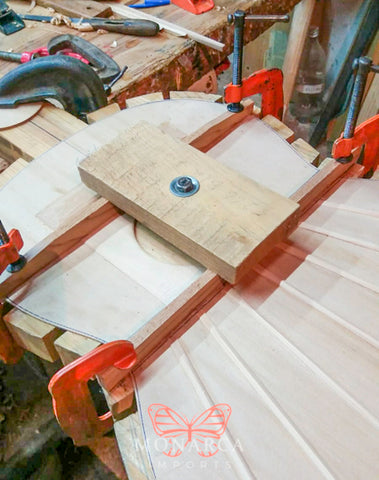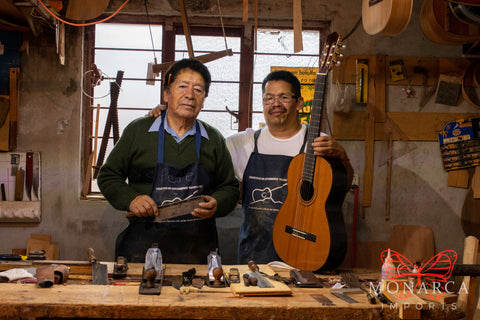Paracho is a town in the state of Michoacán, México, known for its legendary guitars. Guitarreros, the artisans who hand craft the guitars, have been doing so over multiple generations.
"The difference between a handmade guitar and a machine-made guitar is that on the handmade guitar you transmit the essence of the person who makes it"
- Marco Antonio Alfaro Jimenez, Guitarrero
It is in this town that Marco Antonio Alfaro Jimenez, and his father, Mr. J. Jesus Alforo Ceras, have been making guitars for decades. In this article, they walk us through the process of making a guitar.
Marco Antonio's guitar collection 
What matters most when making a good guitar?
Making a guitar by hand takes a lot of effort. The process takes well over 2 weeks to ensure it is done just right. The wood selection needs to be of the finest quality, alignments and precision needs to be exact, and even the climate needs to be just right.
The combination of these factors will yield a durable, solid guitar with excellent sound.

Precision is key when making a guitar
The process of making a guitar
The first part of the process to build a guitar is to work on the front part of its body, or tapa, where the sound hole sits. This, along with the rosette, will give the guitar its stunning appearance.

The tapa is entirely done by hand in Marco Antonio's shop, taking several hours of precision work to get it done just right. This part of the guitar is essential in defining its character and personality.
The ring around the sound hole is called a rosette. The rosette will also give the guitar a very distinctive look. In his premium guitars, Marco Antonio uses a stile from Jose Luis Romanillos, a late Spanish master guitar maker, to adorn the tapa.

Crafting of a guitar rosette
To bring the whole body together, one must carefully calibrate it to ensure it is going to keep its shape and seal right in order to deliver the right quality of sound, for many years to come. A series of supports or internal fortifications are installed, called huanokuas, which is Purépecha (local dialect in Michoacán) for 'bar' or 'reinforcement'.

Installing the huanokuas, or supports, that go inside the guitar body
The neck and headstock are then installed. This is the part of the guitar where the fretboard (or finger board) is located. The fretboard is where you will be “fretting” the guitar, which is the act of putting your fingers in the right place nearby the frets to generate the musical notes.
Lastly, the guitar is painted and gets its cords. The stain the guitar receives will help enhance the wood’s natural colors. Marco Antonio uses two general types: glossy and matte. It is during this stage in which the guitar gets the final touches!

As if the process didn’t require high precision already, each step needs to be performed at a specific temperature and humidity level. Humidity is often controlled by heating the shop to ensure the hardness of the wood is managed during the calibration process.
Each guitar exhibits its deep roots of Paracho, and the generations of people who work them. Marco Antonio and his father ensure each of their guitars get their personal touch, and showcase the pride that comes with making guitars in Paracho.

Why the wood matters
A guitar's sound is made by the precision of its body, and the quality of its wood. The wood needs to be solid enough to deliver timbral quality (great sound) and pass the test of time so the guitar remains a high quality instrument after many years of use.
It is a known fact that a guitar that is well built, it will continue to get richer sound quality as time goes by. This is due to the natural hardening of the wood it is for this reason that the combination of precision calibration and quality wood is crucial to having a great guitar.
The tapa is made from Canadian spruce, and the rest of Palo Escrito wood, originated from the Huasateca Potosina in the state of San Luis Potosi. Palo Escrito is very high quality Mexican Rosewood that will make your guitar a high quality instrument, from the Dalbergia palescrito species.
Palo Escrito is a good that is rigid to offer great sound quality, but flexible enough to shape the guitar. Its resin is what gives this wood its stability over time.
The guitar also uses Granadillo wood from the Chiapas rain forest on its neck.
Marco Antonio’s premier guitars use the optimal wood selection for sound and durability.
 Woods used in high quality, Palo Escrito guitars
Woods used in high quality, Palo Escrito guitars
The guitars that are not made out of Palo Escrito are generally made with red cedar, which is also quality wood.

What makes the guitar special
A handmade guitar from Paracho is a special piece. When you hear its sound, and feel its wood you understand the tradition and generations that stand behind it. Devoting a lifetime to the craft, will truly manifest itself in the quality of the instrument.
¡Saludos desde Paracho, Michoacán!
 Marco Antonio testing a finished guitar
Marco Antonio testing a finished guitar
Guitars from Marco Antonio
To purchase a guitar made by guitarrero Marco Antonio in Paracho, Michoacán, please visit our Paracho guitar collection:
In addition to guitars, Marco Antonio also produces handmade ukuleles.
----------------
To meet our other families of artisans, make sure to visit our article Meet Our Artisans!


Leave a comment